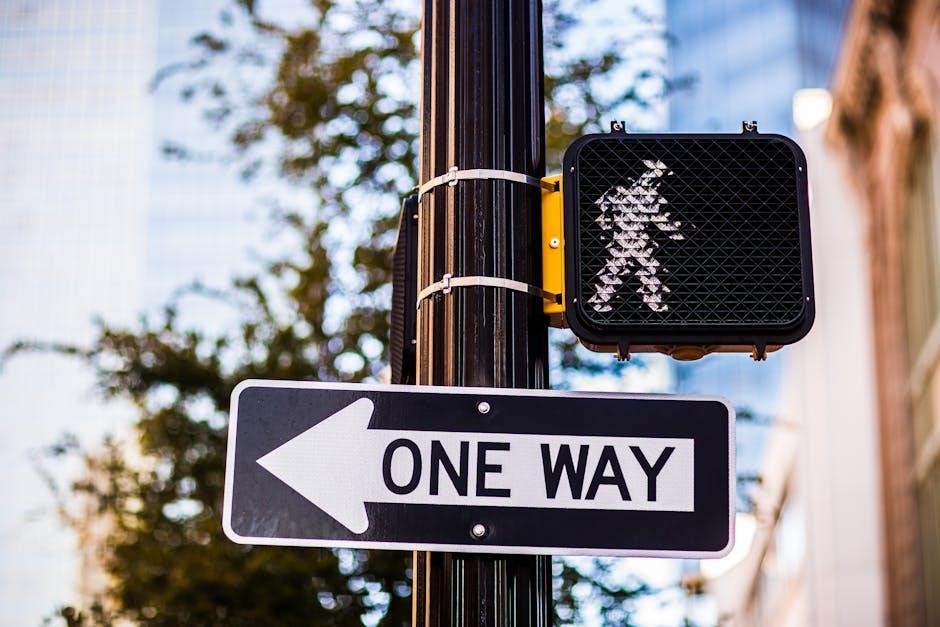panneaux de signalisation routière et leur signification pdf

Road signs are essential for traffic management and safety, providing clear guidance and regulating driver behavior. Their evolution has led to standardized, universally recognized symbols worldwide.

Overview of Road Significance and Their Importance
Road signs play a vital role in maintaining traffic order and safety. They provide clear instructions, warnings, and information to drivers and pedestrians, ensuring smooth traffic flow and reducing accidents. Their standardized designs and colors make them universally understandable, transcending language barriers. From warning drivers about potential hazards to guiding travelers with directional information, road signs are indispensable for efficient navigation. They also enforce legal regulations, such as speed limits and traffic priorities, which are essential for public safety. Understanding these signs is fundamental for all road users, as they help prevent mishaps and promote responsible driving practices.
Evolution of Road Signs Over Time
Road signs have undergone significant transformations since their inception. Early signs were simple and often local, but standardization efforts in the 20th century led to uniform designs globally. Recent updates include the introduction of “Corridor de Sécurité” signs in France, enhancing traffic safety. Spain has also refreshed its catalogue, incorporating modern symbols. The M8a Panonceau, indicating extended traffic rules, exemplifies tailored signage for specific conditions. These advancements reflect evolving traffic needs and improved safety measures, ensuring clearer communication and better driver compliance. Continuous updates adapt to new challenges, such as rising road incivility, demonstrating the dynamic nature of road signage.

Categories of Road Signs
Road signs are categorized into warning, regulatory, informational, and priority signs. Each type serves a distinct purpose, ensuring safe navigation and compliance with traffic laws.
Warning Signs: Indicating Potential Dangers
Warning signs are crucial for alerting drivers to potential hazards, ensuring proactive safety measures. These signs, often triangular with a yellow background, indicate dangers like curves, intersections, or pedestrian crossings. In France, new “corridor de sécurité” signs have been introduced to enhance safety on highways. They are designed to be easily recognizable, preparing drivers for upcoming risks. For instance, the M8a Panonceau specifies the application of traffic rules, ensuring clarity in complex situations. By providing early alerts, warning signs reduce accidents and improve traffic flow. Their standardized design and placement are vital for effective communication, making them indispensable in modern road safety systems.
Regulatory Signs: Laws and Regulations on the Road
Regulatory signs enforce traffic laws and rules, ensuring compliance and order on the road. These signs, often circular with red borders, indicate legal requirements like speed limits, right-of-way, or prohibited actions. In France, new “corridor de sécurité” signs regulate safe corridors on highways, enhancing traffic flow. Spain’s updated catalogue includes refreshed designs to improve clarity. These signs are critical for enforcing traffic laws, maintaining safety, and providing consistent guidance across regions. By adhering to their instructions, drivers uphold legal standards, reducing risks and promoting a structured traffic environment. Regulatory signs are foundational to road safety, ensuring all users understand and follow the rules of the road.
Informational Signs: Providing Guidance and Directions
Informational signs guide drivers and pedestrians by providing details about destinations, distances, and services. These signs help users navigate effectively, reducing confusion and enhancing journey planning. In France, “panneaux d’indication” offer directional guidance, while Spain’s updated catalogue includes improved signage for clearer navigation. Unique signs, like the M8a Panonceau, indicate specific routes or sections, ensuring precise directionality. By displaying place names, distances, and facility information, these signs aid in decision-making. Their clear design and strategic placement make them indispensable for travelers, fostering efficient and stress-free movement. Informational signs are vital for ensuring that road users can easily find their way and access essential services along their journey.
Priority Signs: Ensuring Safe Traffic Flow
Priority signs are crucial for maintaining order and safety in traffic flow. They clearly indicate which drivers have the right-of-way, helping to prevent conflicts at intersections or merging points. Common examples include the “yield” sign, which instructs drivers to slow down and give priority to others, and the “priority road” sign, which designates the main road. These signs are often triangular in shape with red borders, making them easily recognizable. In France, “panneaux de priorité” are essential for ensuring smooth traffic movement, while Spain’s updated catalogue includes refined designs for clarity. The M8a Panonceau, for instance, specifies the application of priority rules, ensuring drivers understand their responsibilities. By guiding drivers effectively, these signs play a key role in reducing accidents and congestion.

New Developments in Road Signage
Recent updates include France’s “corridor de sécurité” signs and Spain’s revised catalogue. Digital integration and adaptive signs are now being introduced to enhance traffic management and safety standards.
Recent Additions to French Road Signs
France has introduced new road signs, including the “corridor de sécurité” series, aimed at improving traffic flow and safety on highways. These signs, referenced as SR53a, SR53b, and SR53c, are placed on high-speed roads with separated carriageways. They indicate designated safety corridors, guiding drivers to maintain safe distances and lanes. Additionally, experimental signs addressing rising road incivility, such as the infamous “doigt d’honneur” gesture, have been implemented to promote respectful driving behavior. These updates reflect France’s commitment to adapting road signage to modern challenges, ensuring clearer communication and enhanced safety for all road users.
Updated Spanish Road Sign Catalogue
Spain has recently updated its official road sign catalogue, introducing fresh designs and additional signs to enhance traffic management. Effective from July 1, 2025, the new catalogue includes updated versions of existing signs and incorporates modern symbols to address contemporary road scenarios. The revisions focus on improving clarity, particularly for bicycle lanes, pedestrian crossings, and low-emission zones. New signs have been added to better regulate traffic flow and prioritize safety in urban and rural areas. This update aligns with Spain’s commitment to adapting road signage to evolving transportation needs, ensuring drivers are well-informed and roads remain safe for all users.
France has introduced new “Corridor de Sécurité” signs, referenced as SR53a, SR53b, and SR53c, to enhance road safety. These signs, placed on highways with separate carriageways, indicate designated safety corridors, ensuring smooth traffic flow and preventing dangerous maneuvers. Their purpose is to guide drivers through specific zones, promoting safer driving practices and reducing accidents. The introduction of these signs reflects France’s commitment to improving road safety and adapting to modern traffic challenges.

Understanding Road Sign Classification
Road signs are classified by shape, color, and purpose, helping drivers quickly interpret their meaning; Shapes like triangles, circles, and rectangles denote warnings, regulations, and information, respectively, ensuring clarity and safety.
Interpretation of Shape and Color in Road Signs
Road signs use distinct shapes and colors to convey specific messages. Triangular signs typically indicate warnings, such as potential hazards ahead. Circular signs often denote regulatory information, like speed limits or prohibitions. Rectangular signs provide directional or informational guidance, while diamond-shaped signs highlight pedestrian crossings or school zones. Colors also play a crucial role: red signifies stops or prohibitions, blue indicates informational messages, yellow highlights caution or temporary conditions, and green guides drivers along routes or toward exits. These visual cues ensure quick comprehension, enhancing safety and efficient traffic flow. Understanding these elements is vital for adhering to traffic rules and navigating roads effectively.
Specialized Signs for Specific Conditions
Specialized road signs are designed to address unique situations or conditions. For instance, the “Corridor de Sécurité” signs in France indicate priority lanes for emergency vehicles, ensuring faster response times. In Spain, updated catalogues include signs for bicycle lanes and electric vehicle charging stations, promoting sustainable transport. Additionally, temporary signs for roadworks or weather conditions, like fog or ice, alert drivers to adjust their speed and caution. These signs are tailored to specific contexts, ensuring clarity and safety. Their implementation reflects evolving traffic needs, adapting to new challenges and technologies while maintaining consistent messaging for driver comprehension and adherence to regulations.
Examples of Unique Signs Like the M8a Panonceau
The M8a panonceau stands out as a specialized road sign, indicating the application of specific regulations ahead. It is often used in conjunction with other signs to clarify their scope, such as the beginning of a restricted zone. This sign is particularly notable for its unique design, featuring a vertical branch that symbolizes the road it applies to. Its presence ensures drivers are aware of ongoing regulations, enhancing compliance and safety. Other unique signs include those for “Corridor de Sécurité,” which prioritize emergency routes, and adaptive signs that adjust based on real-time traffic conditions. These examples highlight the diversity and precision of modern road signage.

Enhancing Road Safety Through Signage
Road signs play a crucial role in enhancing safety by introducing new measures, such as “Corridor de Sécurité” signs, reducing accidents, and improving driver behavior effectively.
Addressing Rising Incivility on Roads
Rising incivility on roads has led to the introduction of new signage aimed at promoting respectful behavior among drivers. In France, for instance, a controversial sign featuring a hand gesture, known as “doigt d’honneur,” gained attention for addressing aggressive driving. These signs visually represent disrespectful actions, serving as a direct reminder to drivers to maintain courtesy. Additionally, awareness campaigns complement these signs, encouraging mindfulness and empathy. Authorities are also experimenting with technology, such as cameras to monitor and penalize uncivil behavior. The goal is to foster a culture of respect, reducing conflicts and enhancing overall road safety. Such measures highlight the evolving role of signage in addressing not just physical but also social challenges on the road.
New Measures to Improve Driver Behavior
New measures are being implemented to enhance driver behavior through updated road signage. In France, the “Corridor de Sécurité” signs have been introduced on highways to create safe corridors, ensuring smoother traffic flow. These signs guide drivers to maintain appropriate distances and lanes, reducing congestion. Spain has updated its official road sign catalogue, incorporating clearer visuals and standardized symbols to improve comprehension. Additionally, experimental signs addressing incivility, such as the “doigt d’honneur” gesture, are being tested to curb aggressive driving. These innovations aim to make roads safer by influencing driver attitudes and actions. Regular updates to signage ensure that drivers are well-informed, fostering a culture of responsible and cooperative driving.

Visual Catalogue of Road Signs in PDF Format
A comprehensive PDF catalogue of road signs is available, detailing their meanings, shapes, and colors. This guide is downloadable and serves as a valuable reference for drivers.
Details and Availability of the Catalogue
The visual catalogue of road signs is available in PDF format, offering detailed information on each sign’s meaning, design, and implementation. Updated regularly, it includes recent additions such as the “corridor de sécurité” signs in France and revised Spanish road sign catalogues. The catalogue is accessible online, providing a comprehensive guide for drivers, educators, and traffic authorities. It features high-quality images, clear classifications, and explanations of shapes, colors, and symbols used in signage. This resource is essential for understanding traffic rules and ensuring safe driving practices. Users can download the PDF from official transportation websites or request physical copies from local road safety associations.

Importance of the Visual Guide for Drivers
The visual guide is a crucial tool for understanding road signs, enhancing driver awareness and safety. It provides clear, standardized interpretations of signage, reducing confusion and accidents. By detailing shapes, colors, and symbols, the guide helps drivers recognize warnings, regulations, and directional information quickly. It also serves as a valuable resource for learning traffic rules and staying updated on new or modified signs. The guide is particularly useful for educating new drivers and refreshing experienced ones. Its availability in PDF format ensures accessibility for widespread use. Regular updates keep the content relevant, addressing emerging traffic challenges and promoting a safer driving environment for all road users.

Future Trends in Road Signage
Future road signs will integrate digital technology, offering real-time updates and smart traffic management. Adaptive signs will improve dynamic traffic flow and enhance safety for all road users.
Digital Integration and Smart Traffic Signals
Digital integration is revolutionizing road signage by incorporating real-time updates and smart traffic management. IoT-enabled traffic signals adapt dynamically to congestion, reducing bottlenecks and improving flow. AI-driven systems analyze traffic patterns to optimize signal timing, enhancing efficiency. Digital signs now display variable messages, providing drivers with crucial information like accidents, weather conditions, or road closures. Mobile apps integrate with these systems, offering drivers personalized route suggestions. Energy-efficient LED technology powers these smart signs, ensuring sustainability. This fusion of technology and infrastructure aims to create safer, more responsive road networks, addressing modern traffic challenges effectively while preparing for autonomous vehicles. The future of road signage lies in seamless digital integration.
Adaptive Signs for Dynamic Traffic Management
Adaptive road signs are transforming traffic management by responding in real-time to changing conditions. These intelligent signs use sensors, cameras, and AI to monitor traffic flow, accidents, and weather, adjusting messages accordingly. For instance, digital signs can change speed limits during heavy traffic or display detour routes after an accident. They also optimize lane usage, such as opening hard shoulder lanes during peak hours. This dynamic approach reduces congestion, lowers crash risks, and enhances overall traffic efficiency. Adaptive signs are particularly effective in urban areas with fluctuating traffic patterns. Their ability to provide instant, relevant information makes them a cornerstone of modern road safety and mobility solutions, ensuring smoother and safer journeys for all drivers.

Road signs are vital for ensuring safety and efficient traffic flow. Recent innovations like “corridor de sécurité” signs highlight their evolving role in modern transportation systems.
Summarizing the Role of Road Signs
Road signs play a critical role in ensuring road safety, guiding drivers, and managing traffic flow. They are categorized into warning, regulatory, informational, and priority signs, each serving specific purposes. Warning signs alert drivers to potential hazards, while regulatory signs enforce traffic laws. Informational signs provide directions or details about services, and priority signs help maintain order at intersections. The introduction of new signs, such as the “corridor de sécurité” in France and updated Spanish road sign catalogues, reflects ongoing efforts to enhance safety. These signs are designed to be universally understood, making them essential for efficient and safe transportation worldwide. Their evolution addresses rising challenges like incivility and dynamic traffic conditions, ensuring they remain relevant and effective in modern transportation systems.
Looking Ahead to Future Innovations
The future of road signage is poised for transformative advancements, blending technology and design for enhanced safety and efficiency. Digital integration and smart traffic signals will enable real-time adjustments based on traffic conditions, while adaptive signs will dynamically manage traffic flow. Innovations like the “corridor de sécurité” in France and updated Spanish road sign catalogues demonstrate a commitment to modernizing road safety. These changes are expected to improve driver behavior and address rising challenges such as incivility on the roads. By leveraging technology and updating signage systems, the goal is to create smarter, more responsive traffic networks that prioritize safety and sustainability for all road users.



Leave a Reply
You must be logged in to post a comment.